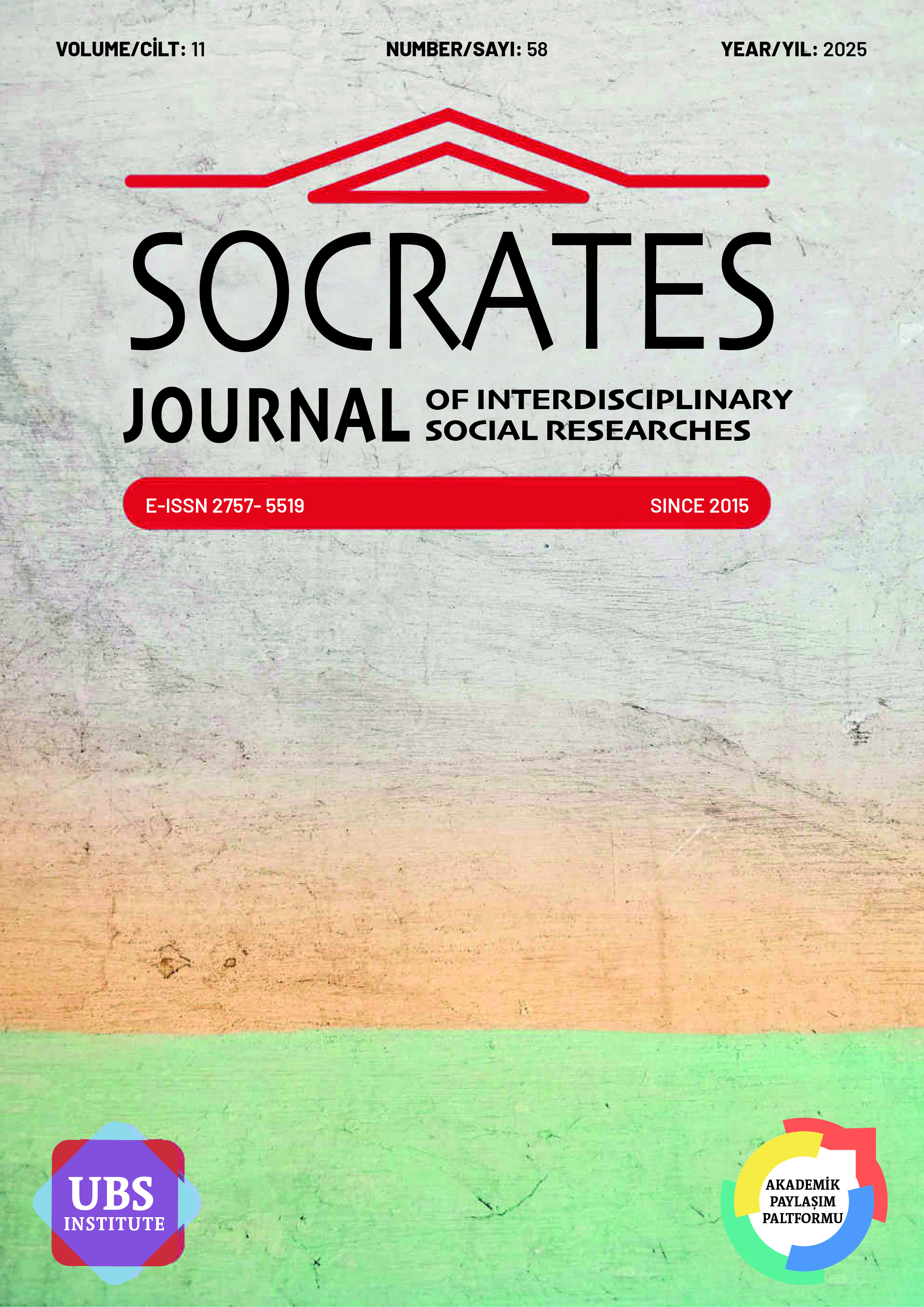THE IMPACT OF SPATIAL INEQUALITIES IN ACCESSIBILITY ON CONSUMER PREFERENCES: A GEOGRAPHICAL APPROACH TO SHOPPING MALL USAGE
ERİŞİLEBİLİRLİKTEKİ MEKÂNSAL EŞİTSİZLİKLERİN TÜKETİCİ TERCİHLERİ ÜZERİNDEKİ ETKİSİ: ALIŞVERİŞ MERKEZİ KULLANIMINA COĞRAFİ BİR YAKLAŞIM
DOI:
https://doi.org/10.5281/zenodo.17481034Keywords:
Spatial Inequality, Accessibility, Shopping Mall, Consumer Behavior, Geographical ApproachAbstract
This study aims to examine the reflections of spatial inequalities emerging in urban spaces on consumer behavior, within the context of shopping mall (SM) usage. The influence of spatial parameters such as accessibility, locational justice, and access to transportation infrastructure on individuals’ SM preferences is evaluated using a geographical approach. Statistical methods are employed to analyze how these preferences are shaped in interaction with socio-demographic variables. Multivariate statistical analyses were conducted using data collected from 400 participants in the city of Gaziantep, which was selected as the research area.
A survey form with established construct validity was used as the data collection tool. The collected data were analyzed through Exploratory Factor Analysis (EFA), Multiple Linear Regression, Logistic Regression, One-Way Analysis of Variance (ANOVA), Cluster Analysis, and Correlation Analysis. Factor analysis revealed that variables clustered under two dimensions: accessibility and behavioral tendency. While regression models indicated that spatial factors have a statistically limited effect on SM preferences, logistic regression results showed that individuals’ behavioral shifts in response to the opening of a new SM are weakly associated with spatial and socio-demographic variables. Although ANOVA analyses pointed to some behavioral differences based on education and income levels, most of these differences did not reach statistical significance. Cluster analysis categorized consumers into three main profiles: “Frequent Visitor with Transportation Barriers,” “Loyal with Easy Access,” and “Planning-Oriented with Moderate Distance.” Correlation analyses showed generally weak relationships among variables, with a notable positive correlation between transportation problems and perceived location.
References
Akan, G. H. (2009). Algılama yönetiminin tüketici davranışları üzerindeki etkisi: saha araştırması [Yüksek lisans tezi]. Marmara Universitesi.
Akbulut, F. (2016). Kentsel ulaşım hizmetlerinin planlanması ve yönetiminde sürdürülebilir politika önerileri. Kastamonu Üniversitesi İktisadi ve İdari Bilimler Fakültesi Dergisi, 11(1), 336-355.
Aksu, B. ve Tutar, C. (2021). Neoliberal toplumsal dinamikler ekseninde kentsel mekânların kurgusu: Karaköy örneği. Etkileşim, (8), 108-131.
Atkinson, R., & Bridge, G. (Eds.). (2005). Gentrification in a global context: The New Urban Colonialism. Routledge.
Beyazıt, E. (2019). Hatay kent kimliği. Detay Yayıncılık.
Büyüköztürk, Ş., Akgün, Ö. E., Demirel, F., Karadeniz, Ş. ve Çakmak, E. K. (2015). Bilimsel araştırma yöntemleri. Pegem Akademi.
Ceylan, R. ve Özbakır, A. (2018). Alışveri̇ş merkezleri̇ni̇n Türki̇ye’deki̇ mevzuat çerçevesi̇nde değerlendi̇ri̇lmesi̇. METU Journal of the Faculty of Architecture, 34(2), 245-264.
Çevik, N. K. ve Kıran, R. E. (2022). Bireylerin tüketim tercihlerinde etkili olan sosyo-demografik faktörlerin belirlenmesi: Türkiye örneği. Gaziantep Üniversitesi Sosyal Bilimler Dergisi, 21(4), 1967-1988.
Çiçek, Ö. Ü. (2022). Kentsel sosyal hizmetler. Kentsel Kamusal Hizmetler, 203.
Erdoğan, Ö. (2013). Ankara kentindeki alışveriş merkezlerinin yer seçim tercihleri ve mekansal etkileri [Yüksek lisans tezi]. Ankara Universitesi.
Erkip, F., & Özüduru, B. (2015). Retail planning and urban resilience: Exploring the connections through a multiple-case study in Turkey. METU Journal of the Faculty of Architecture, 32(2), 85-108.
Fainstein, S. S. (2010). The Just City. Cornell University Press.
Geurs, K. T., & van Wee, B. (2004). Accessibility evaluation of land-use and transport strategies: Review and research directions. Journal of Transport Geography, 12(2), 127-140. https://doi.org/10.1016/j.jtrangeo.2003.10.005
Goss, J. (1993). The magic of the mall: An analysis of form, function, and meaning in the contemporary retail built environment. Annals of the Association of American Geographers, 83(1), 18-47. https://doi.org/10.1111/j.1467-8306.1993.tb01921.x
Gökmen Köksal, Y., & Tığlı, M. (2018). Factors influencing consumers’ shopping mall preferences: A study on Turkey. Karadeniz Technical University Journal of Social Sciences Institute, 8(15), 237-259.
Hansen, W. G. (1959). How accessibility shapes land use. Journal of the American Institute of Planners, 25(2), 73-76. https://doi.org/10.1080/01944365908978307
Harvey, D. (1973). Social Justice and the City. Edward Arnold.
İpekçi, M. V. (2014). AVM’lerin tüketim kültürüne etkisi ve Türkiye örneği [Doktora Tezi]. İstanbul Üniversitesi.
Jones, P., & Lucas, K. (2012). The social consequences of transport decision-making: Clarifying concepts, synthesising knowledge and assessing implications. Journal of Transport Geography, 21, 4-16. https://doi.org/10.1016/j.jtrangeo.2012.01.012
Kıncal, R., Şahin, Ç., Köse, E., Yeşil, R., Genç, S. Z., Özerbaş, A., ... ve Özbek, R. (2010). Bilimsel araştırma yöntemleri. Nobel Akademik Yayıncılık.
Koçgar, M. E. (2013). Tüketici davranışlarını etkileyen faktörler ve kültür: Eskişehir’de kültürün tüketim tercihleri üzerine etkisi [Yüksek lisans tezi]. Anadolu Üniveristesi.
Koçyiğit, A. (2015). Alışveriş merkezlerinin yer seçimi ölçütleri üzerine karşılaştırmalı bir çalışma: Ümraniye örneği [Doktora tezi]. Bahçeşehir Üniversitesi.
Marcuse, P., & van Kempen, R. (Eds.). (2000). Globalizing cities: A new spatial order? Blackwell Publishers.
Mucuk, S. (2014). Tüketici satın alma davranışı kapsamında hedonik (hazcı) tüketimin plansız alışveriş üzerine etkilerinin incelenmesi [Yüksek lisans tezi]. Karamanoğlu Mehmetbey Üniversitesi.
Muğan, E. (2018). Modern kent yaşamında alışveriş merkezlerinin yeri ve önemi: Erişilebilirlik ve kullanılabilirlik bağlamında bir değerlendirme.
Muğan, E. (2018). Shopping malls: Accessibility, usability, and spatial quality. Chamber of Architects Ankara Branch, Dosya Journal, (36), 70-80.
Nordbakke, S., & Schwanen, T. (2014). Well-being and mobility: A theoretical framework and literature review focusing on older people. Mobilities, 9(1), 104-129. https://doi.org/10.1080/17450101.2012.750091
Olcar, C. ve Özkaynak, M. (2023). Mekansal adalet kavramı bağlamında tarihi alanların morfolojik yaklaşımla değerlendirilmesi: Amasya İçeri şehir örneği. Online Journal of Art ve Design, 11(4), 247-261.
Özkul, B. (2020). Kentsel iç mekan olarak alışveriş merkezi ortak alanlarının kullanımı. [Yüksek lisans tezi]. İstanbul Kültür Üniversitesi.
Saygılı, T. (2011). Gençlerin tüketim davranışlarını etkileyen sosyo-kültürel faktörler: Sakarya Üniversitesi ve Kırgızistan-Türkiye Manas Üniversitesi örneği [Yüksek lisans tezi]. Sakarya Üniversitesi.
Selçuk, İ. A. ve Szeri, R. (2019). Eşitlik, erişilebilirlik ve toplu taşıma. İdealkent, 10(28), 1207-1229.
Smith, N. (1996). The new urban frontier: Gentrification and the revanchist city. Routledge.
Şentürk, Ü. (2012). Tüketim toplumu bağlamında boş zamanların kurumsallaştırdığı bir mekân: alışveriş merkezleri (AVM). Pamukkale Üniversitesi Sosyal Bilimler Enstitüsü Dergisi, (13), 63-77.
Timothy, D. J., & Butler, R. W. (1995). Cross-border shopping: A North American perspective. Annals of Tourism Research, 22(1), 16-34. https://doi.org/10.1016/0160-7383(94)00030-3
Zukin, S. (1998). Urban lifestyles: Diversity and standardisation in spaces of consumption. Urban Studies, 35(5-6), 825-839.
Downloads
Published
How to Cite
Issue
Section
License
Copyright (c) 2025 Socrates Journal of Interdisciplinary Social Studies

This work is licensed under a Creative Commons Attribution 4.0 International License.


